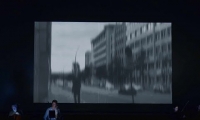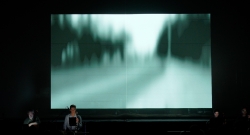Joanna Bailie: 1979 (*)
for 8 musicians, electronics and video,
2023, 45'
 >Listen to 1979
>Listen to 1979
Joanna Bailie: Roll Call
for piano, tape and video,
2018, 16'
CAST
Violins: Igor Semenoff, Clara Lévy
Viola: Victor Guaita
Cello: François Deppe
Flute: Chryssi Dimitriou
Bass clarinet: Martijn Susla
Trombone: Adrien Lambinet
Piano: Marina Delicado
Sound: Vincent Debongnie

Production ictus
Co-production Donaueschinger Musiktage, Venice Biennale, Rainy Days Luxemburg, Wien Modern, Ictus, deBijloke Gent
(*) Co-commission of 1979: Donaueschinger Musiktage, Venice Biennale, Rainy Days Luxemburg, Wien Modern, Ictus, deBijloke Gent
The Joanna Bailie website

For me there is no doubt that my sense of nostalgia has been growing steadily as I’ve become older. This is both logical and inevitable: the gaps between the present and things of my own ‘yesteryear’ are lengthening to the point where the past has become fuzzy, difficult to remember and consequently, full of mystique. My yesteryears have now turned into eras — the 70s, 80s and 90s have been digested, and each stamped with a distinctive set of attributes. However, I’m not so interested in universal ideas of decades, but rather in my own personal ones. I want to understand how the times that I lived through collided with my individual experience and created memories tinged with the colour of an era. Did life look, sound and feel different from how it does today? I believe that the answer is yes, though I have no way of proving it to you. All I have is the strange tickling sensation in the back of my mind when I try to remember, for instance, 1979, a year of great upheaval for the 5-year-old me, and probably the first time I was aware of the times that I was living in.
In 1979, the effort of remembering is brought together with another, almost contrary notion, the theory that no sound in a space is ever truly lost — that acoustic waves continue to exist long after the initial source has left the room, bouncing between the walls at ever more minuscule amplitudes for eternity. This theory, whose proponents included figures such as Charles Babbage and Guglielmo Marconi inhabits an intersection between the advent of recording technology, science fiction, memory and poetics. Nearly 100 years after Marconi’s speculations on the everlasting nature of sound, we still have no way of detecting or capturing these super-low amplitude waves, or indeed have any evidence that they exist at all. What is certain though, is that the very idea of them, of their steady and quiet accumulation into a theoretical background noise, and the way they might function as a kind of memory of a space, is a seductive one.
And so, the two principal musical processes in the piece are the layering and accumulation of sounds on the one hand and the repetition of these sounds as they are reflected between walls. What could be termed the ‘delay spectrum’ – a range of natural and manmade phenomena starting with reverberation at one end, and passing through comb filtering effects, echo and imitative polyphony on the other, is presented in different forms throughout the course of the work. The sound source for 1979 is also twofold — cars and songs. In many ways the piece is an attempt to unite these two sources by subjecting them to the same processes of accumulation and repetition. The fragmented melodies of cars become songs because they are repeated, songs turn into something resembling ambient street noise through being piled up on top of one other. The space in which these forever-reflecting sounds are gathered is an imaginary one, an amalgamation of 1979 living rooms — pop music playing on the television, the noise of the road outside streaming in through the windows.
Joanna Bailie

De productie is geïnspireerd op een kortverhaal van de Duitse schrijver Salomo Friedlaender ‘Goethe spricht in den Phonographen’, geschreven in 1916 en in zijn geheel opgenomen in Friedrich Kittlers boek Gramophone, Film, Typewriter. Het kortverhaal vertelt hoe een professor, die indruk wil maken op de vrouw van wie hij houdt, een bezoek brengt aan Goethes studeerkamer en probeert de stem van de allang overleden schrijver te vangen en te reproduceren. Het experiment van de professor is gebaseerd op de theorie dat geen enkel geluid in een ruimte ooit volledig verloren gaat – dat geluidsgolven blijven bestaan lang nadat de oorspronkelijke bron de kamer heeft verlaten, en op een steeds kleiner wordende amplitude heen en weer stuiteren tussen de muren, tot in de eeuwigheid.
het geheugen van een ruimte
Friedlaenders verhaal situeert zich op het kruispunt van de eerste opnametechnologie, sciencefiction, het geheugen en poëzie, en die plek is het uitgangspunt voor een meer hedendaagse benadering: een stuk voor een wereld die vergeten is hoe dingen werken. Honderd jaar nadat het verhaal is geschreven, zijn we er nog altijd niet in geslaagd die geluidsgolven op extreem lage amplitudes te ontdekken of te capteren, we hebben nog niet eens bewezen dat ze überhaupt bestaan. Wat we daarentegen wel zeker weten, is dat het idee dat ze bestaan, dat ze zich continu, stilletjes op elkaar stapelen tot theoretisch achtergrondlawaai, en dat ze misschien een soort geheugen van een ruimte vormen, een heel verleidelijk idee is. De gangbare theorieën dat geluid vluchtig en ongrijpbaar is, worden op hun kop gezet en vervangen door het idee dat geluid een materie is die groeit.
van geluid naar lied
Wat zouden we horen in een ruimte als we het volume kunnen versterken van alles wat ooit in die ruimte heeft weerklonken? In 1979 staan muzikanten en sprekers langs de muren van een vertrek, ze symboliseren de punten waar geluiden tegen de muren botsen, een enscenering van een heel theoretisch idee. De geschiedenis van een ruimte is in stukken verdeeld door een soort sonisch equivalent van time-lapse fotografie en zo ontstaat er een performance van 45 minuten. In deze productie wordt de tijd achteruitgedraaid, de voorstelling begint dus met een maximale verzameling geluiden en die worden beetje bij beetje ontrafeld tot men terugkeert tot bij het allereerste ‘geluid’, losse liedflarden. De speculatieve wetenschap en de complexiteit krijgen een tegengewicht mee, de transparante aanpak en het verlangen om het menselijke verhaal te vinden dat de kern van deze theorie vormt. Sonische weerkaatsing (of ‘echo’) ontpopt zich tot een fenomeen waarbij de geschiedenis zichzelf onthult en vormt de basis voor een alternatieve muzikale dramaturgie.
Joanna Bailie

Je dois bien avouer que mon sentiment de nostalgie ne cesse de croître tandis que je prends de l'âge. C'est sans doute logique et inévitable : l’écart entre le présent et les images que je retiens du passé s’accentue, au point que ce passé devient flou, difficile à mémoriser, et qu’il se charge au bout du compte d’une sorte d'aura mystique. Mes années d'antan se sont transformées en époques — les années 70, 80, 90, tout cela a été digéré, et chacune de ces époques est désormais marquée par un ensemble d'attributs distinctifs. Cependant, je ne m'intéresse pas tant aux idées communément admises sur la valeur de chaque décennie qu'à mes propres positions sur la question. Je veux comprendre comment les années que j'ai vécues se sont heurtées à ma propre expérience, produisant des souvenirs teintés aux couleurs de leur temps. La vie a-t-elle parfois été différente de ce qu'elle est aujourd'hui ? Je crois que la réponse est oui, sans avoir le moyen de vous le prouver. Ce dont je peux faire part, c'est de cet étrange picotement qui me prend au fond de l’esprit lorsque j'essaie de me souvenir, par exemple, de 1979, une année de grands bouleversements pour l'enfant de 5 ans que j'étais — et probablement la première fois que j'ai pris conscience que je vivais dans un temps.
Dans 1979, l'effort de mémoire est associé à une autre notion, presque contraire celle-là : l'intuition théorique selon laquelle aucun son ne serait jamais vraiment perdu dans un espace, l’onde sonore continuant d’exister longtemps après que sa source a quitté la pièce, ricochant pour l’éternité sur les murs en des amplitudes de plus en plus faibles. Cette théorie, qui a été défendue par des personnalités telles que Charles Babbage et Guglielmo Marconi, se situe à la croisée de la science-fiction, de la poésie, de la théorie de la mémoire et de l’étude des technologies d’enregistrement. Près de 100 ans après les spéculations de Marconi sur la survivance éternelle du son, nous n'avons toujours aucun moyen de détecter ou de capturer ces ondes de très faible amplitude, et n'avons aucun indice de leur existence. Ce qui est certain, en revanche, c’est que l’idée même de leur présence, de leur accumulation progressive et silencieuse en un bruit de fond virtuel, et l'idée qu'elles pourraient constituer le fonds de mémoire d’un espace, est parfaitement séduisante.
Ainsi les deux principaux processus musicaux de la pièce sont-ils la superposition et l'accumulation de sons, d'une part, et la répétition de ces sons lorsqu'ils sont réfléchis entre les murs, d'autre part. C'est ce que j'appelle le « nuancier des échos » (the delay spectrum), qui couvre toute une gamme de phénomènes naturels et artificiels : de la simple réverbération jusqu'à la polyphonie par imitation, en passant par les effets de filtre en peigne et les delays électroniques.
Le matériel sonore de 1979, lui aussi, est double : ce sont les voitures et les chansons. À bien des égards, la pièce est une tentative d'unir ces deux sources en les soumettant aux mêmes processus d'accumulation et de répétition. Les mélodies fragmentées du son des voitures deviennent des chansons lorsqu'elles sont répétées, tandis que les chansons se transforment en quelque chose qui ressemble à une atmosphère de rue lorsqu'on les empile les unes sur les autres. L'espace dans lequel se rassemblent tous ces sons, rebondissant à l'infini, se matérialise ici sous la forme d’un site imaginaire, que je vois comme sorte un archétype d’une salle de séjour en ’79 : il y a de la pop qui passe à la télé, tandis que le bruit de la rue entre doucement par les fenêtres.
Joanna Bailie
Agenda for this project
- Date Show Location
-
Sat 21.10 1979 (Joanna Bailie) Musiktage - Donaueschingen - Germany

-
Mon 23.10 1979 (Joanna Bailie) La Biennale di Venezia - Venice - Italy

- Date Show Location
-
Sat 18.11 1979 (Joanna Bailie) Rainy Days - Luxembourg - Luxembourg

-
Thu 23.11 1979 (Joanna Bailie) Konzerthaus (Wien Modern) - Wien - Austria



